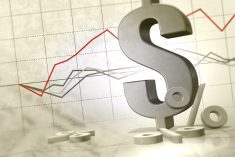The United States is in a “huge fiscal hole,” and the greenback is set to plunge, sending the loonie soaring above parity, according to a prominent Canadian economist.
“We think the loonie is going to fly high and probably break through par,” said Glen Hodgson, senior vice-president and chief economist of the Conference Board of Canada (CBOC), in an address to the International Livestock Congress recently held in Calgary.
“We’re actually forecasting it to go to $1.02 to $1.03 in the first part of 2011.”
Read Also

Pig transport stress costs pork sector
Popular livestock trailer designs also increase pig stress during transportation, hitting at meat quality, animal welfare and farm profit, Agriculture and Agri-Food Canada researcher says
The loonie’s status as a petrodollar linked to global oil prices is part of the reason.
With oil at roughly $80 per barrel – the range most comfortable for price setter Saudi Arabia – and likely to gradually rise to $95 over the next couple of years, that will push the Canadian dollar higher.
“So, if you are planning for your business, plan for par, plan for parity,” said Hodgson.
Interest rates are going up, too, as Canada’s economy grows at CBOC’s forecasted rate of 3.6 per cent this year.
The Bank of Canada rate, at 0.75 per cent, will keep rising one to two per cent per year until they reach the “normal” rate of four to 4.5 per cent to keep pace with inflation at two per cent per year.
“It will probably take the banks about 18 months to get back there in Canada,” he said. “Lock in. In Canada, rates are only going in one direction.”
Hodgson predicted that full employment in the country would return by 2012, leading to chronic labour shortages and headaches for employers.
The global economy is coming out of the worst recession since 1947, but “nobody believes it,” and “fear and uncertainty” abound.
Since the fall of 2008, more than eight million jobs have been lost south of the border, leaving unemployment at 9.5 per cent. Peak to trough, the stock market there fell 40 per cent, and the average house price has fallen by one-third. Some 10 million to 12 million U. S. households are “underwater,” which means they are stuck paying more for their mortgage than their home is currently worth.
Over the last two years, the U. S. Federal Reserve has resorted to extraordinary measures to prop up confidence in the economy, including everything from slashing interest rates effectively to zero, to “quantitative easing” – creating credit out of thin air and using it to buy their own government bonds.
“A three-month bond has a yield of 0.21,” said Hodgson. “If there is a double dip, the Fed will do even more. They may even start charging banks for the privilege of parking money with the Fed.”
All of these extreme measures are aimed at flooding the economy with liquidity, encouraging spending, and restoring consumer and business confidence.
If Federal Reserve chairman Ben Bernanke makes good on his recent pledge to keep interest rates at rock-bottom lows for as long as it takes to spark a rebound, the U. S. dollar has nowhere to go but down, he said.
The grand experiment underway down south is important, because the American consumer represents 70 per cent of their economy, or 15 per cent of global consumption.
Europe is arguably in even worse shape, and unless American jobs start returning, global gross domestic product, a number representing economic growth in all countries, will be anemic at just one or two per cent a year for the next half a decade as governments reverse fiscal stimulus measures, he added.
Travis Toews, president of the Canadian Cattlemen’s Association, noted that with a 63-cent dollar – as it was in 2002 – today’s U. S. cattle prices would “make your head spin.
“We would be in pretty good times. But the reality is, we’re not likely to go back there anytime soon,” said Toews. “We can’t hide behind the low dollar anymore.”
The Canadian cattle industry can no longer tolerate regulatory, production, or marketing “inefficiencies,” he added.
“As an industry, we have to fix the competitiveness issues so that we can compete,” said Toews. [email protected]


















